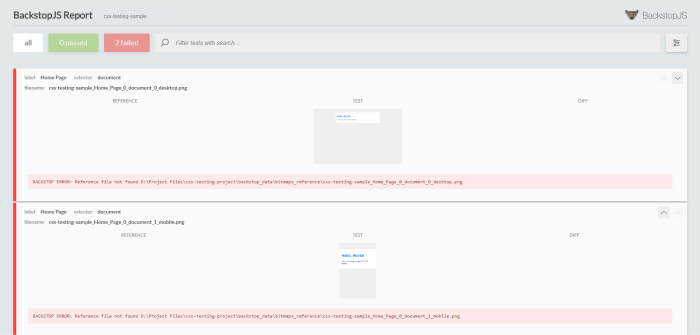CSS Testing
Have you ever been in a situation where your system looks fine on your device, but the moment it lands in the hands of another – everything goes wrong?
Well, that’s what happens when you don’t test your CSS well enough. CSS testing isn’t just about verifying the correctness of your CSS code. It’s a process that helps you ensure that the CSS you write scales well across multiple devices without an issue while performing well.
So, let’s take a look at what CSS testing really is all about and understand how you can get started with it.
What is CSS Testing?
CSS testing is executed to confirm that CSS plays and responds accurately, speedily, and regularly throughout all those components of a site or web application. Automated CSS testing ensures that changes in your stylesheets don’t introduce visual bugs or inconsistencies in your web application. This type of testing covers various aspects, such as regression testing, syntax checking, adherence to project standards, and visual reference comparisons.
Why Should You Care About CSS Testing?
CSS is a fundamental part of web development. It controls the layout, design, and overall look of your web applications. A simple mistake within CSS can cause a broken layout, poor user experience, and loss of user trust in the long run.
Here are key reasons why CSS testing is crucial:
- Quality assurance: Ensures your web application looks as intended across different devices and browsers.
- Consistency: Helps maintain a consistent look and feel throughout your application.
- Efficiency: Automates the process of detecting visual bugs and syntax errors, saving time and effort.
- User experience: Ensures that users have a smooth and visually pleasing experience.
How Do You Test CSS?
CSS testing can be approached in several ways. Each method addresses different aspects of CSS validation and error detection:
- Regression testing ensures new CSS changes don’t mess up existing styles. This involves taking screenshots of web pages before and after changes to spot any differences.
- Syntax testing involves checking the CSS code for syntax errors. Tools like linters can enforce coding standards and ensure that the CSS code is error-free.
- Project standards: This method checks whether the CSS adheres to the standards and guidelines set by the project or organization. It ensures consistency and maintainability of the CSS code.
- Reference testing involves comparing the rendered web page against a reference image to ensure it looks as expected. This is crucial for visual consistency across different browsers and devices.
CSS Testing Tools
Several tools can help automate and streamline the CSS testing process. Here are some of the main ones:
- CSS Lint: This tool checks your CSS code for syntax errors and potential issues. It can be customized to enforce specific coding standards and rules.
- BackstopJS: This visual regression testing tool captures and compares screenshots of your web pages to identify visual changes. It integrates well with CI systems and can be automated to run with every code commit.
- Quixote: A library designed for unit and integration testing of CSS. It helps you verify how elements are rendered and how they relate to each other. Quixote works in modern browsers and integrates with tools like Karma to run tests across multiple browsers.
- CSSCritic: This is a tool for automatic regression testing of CSS. It compares the current state of your layout to a reference image and highlights differences. It supports only Firefox and Chrome but is useful for catching visual regressions.
Implementing CSS Testing
CSS testing ensures that your web application looks and functions correctly across different browsers and devices. Here’s a step-by-step guide to implementing CSS testing in your development workflow using BackstopJS.
Steps to Implement CSS Testing
- Set up testing tools: Install BackstopJS using the following command:
$ npm install -g backstopjs $ backstop init
- Create baseline images: Snap some baseline images of your web pages to use as a reference for future comparisons.
$ backstop reference
- Integrate with CI/CD: Integrate BackstopJS with your CI/CD pipeline to automatically run tests on every code commit. This ensures early detection of visual bugs.
- Write tests: Configure your tests to check the rendering of specific elements and pages. Using BackstopJS, you can create a configuration file (backstop.json) to specify the test scenarios. Here’s an example configuration:
{
"id": "backstop_default",
"viewports": [
{
"label": "desktop",
"width": 1280,
"height": 800
},
{
"label": "mobile",
"width": 320,
"height": 480
}
],
"scenarios": [
{
"label": "Home Page",
"url": "http://localhost:3000",
"selectors": ["document"],
"misMatchThreshold": 0.1
},
{
"label": "Contact Page",
"url": "http://localhost:3000/contact",
"selectors": ["#contact-form"],
"misMatchThreshold": 0.1
}
],
"paths": {
"bitmaps_reference": "backstop_data/bitmaps_reference",
"bitmaps_test": "backstop_data/bitmaps_test",
"engine_scripts": "backstop_data/engine_scripts",
"html_report": "backstop_data/html_report",
"ci_report": "backstop_data/ci_report"
},
"report": ["browser"],
"engine": "puppeteer",
"engineOptions": {
"args": ["--no-sandbox"]
}
}
- Run tests: Execute the tests using the following command:
$ backstop test
BackstopJS will capture screenshots and compare them to the baseline images, generating a report that highlights any visual differences.
- Monitor and maintain: Regularly review test results and update reference images and rules as needed. This helps ensure that your CSS remains consistent and error-free.
Best Practices for CSS Testing
To get the most out of CSS testing, consider the following best practices:
- Automate: Automate CSS testing as much as possible. This reduces the manual effort required and ensures that tests are consistently run.
- Integrate early: Integrate CSS testing early in the development process. Catching issues early reduces the cost and effort of fixing them later.
- Use version control: Store your baseline images and test configurations in version control. This helps track changes over time and ensures consistency across different environments.
- Regularly update baselines: Update your baseline images regularly to reflect intentional design changes. This prevents false positives in your test results.
- Collaborate: Involve your team in the CSS testing process. Collaborating on test creation and maintenance ensures that everyone is aware of the importance of CSS testing and contributes to maintaining quality.


